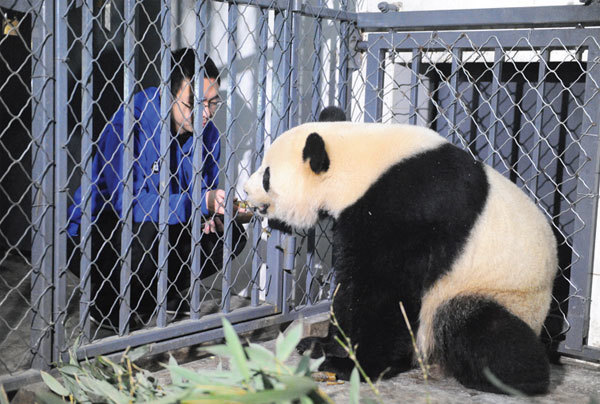
Bao Bao eats bamboo at the Dujiangyan Panda Base of China Conservation and Research Center in Sichuan.
Li Chuanyou / For China Daily
Bao Bao, the US-born panda cub returned to China, has quickly adapted to her new home in Sichuan province, despite a flight of nearly 17 hours from the United States.
"She isn't nervous and feasts on bamboo normally," said Zhang Hemin, chief of the China Conservation and Research Center in Sichuan.
The FedEx aircraft transporting Bao Bao arrived in the Chengdu airport in Sichuan at 6:59 pm on Wednesday. After quarantine and customs formalities, she arrived at the Dujiangyan base of Zhang's center at 10:30 pm.
Bao Bao ate, drank and slept normally during the smooth flight.
"Bao Bao was a real champion during the flight. All the weeks of training and preparation served her really well," said Bao Bao's American keeper Marty Dearie. "She's in excellent hands now and I'm glad I get to transition with our Chinese partners and have my 'goodbye' in a couple days."
Bao Bao will be in quarantine for one month before she meets visitors in the Dujiangyan base near Mount Qingcheng, a Taoist mountain known for its lush forests and tranquility.
The Dujiangyan Panda Base is home to Bao Bao's 12-year-old brother Tai Shan who had charmed millions of Americans during his stay at the Smithsonian's National Zoo in Washington for four and a half years before he returned to Sichuan in February 2010.
All the overseas returned pandas have to go through the month-long quarantine period to see if they are physically sound. Although all of them can go through the period, some are restless, walking from one corner to the other in their dens or even climbing to the window, Zhang said.
Bao Bao, who is three and a half years old and weighs 209 pounds, is quick in her adaptability and seems calm in her den, said Zhang, a veteran panda researcher.
His center has reintroduced seven pandas into the wild after training them how to survive since 2006. Two perished, while the other five are believed to be faring well in the Liziping Nature Reserve in Sichuan.
The purpose of breeding captive pandas is to conduct research and return them to the wild to enlarge the wild panda population and prevent their extinction, Zhang said.
China's fourth panda census, the results of which were released in 2015, showed there were only 1,864 wild pandas and 375 captive pandas worldwide as of the end of 2013.
Zhang's center was set up in 1980 under an agreement between the World Wide Fund for Nature, formerly the World Wildlife Fund, and the Chinese government to save the cuddly bear from extinction.
After the quarantine period is over, the center will consider if Bao Bao is qualified to be trained to survive in the wild, Zhang said.
The first panda his center released into the wild was Xiang Xiang, who was born in 2001. The male panda was released in 2006. In 2007, his body was found in the woods, with broken ribs and injuries to his ears and back. Researchers suspected he had taken refuge in a tree after fighting with wild pandas, but had fallen.
His death forced handlers to revise their approach to training pandas to survive in the wild. They started training female pandas to be released into the wild.
Female pandas might be more likely to integrate into the wild panda population. Releasing a captive panda into the wild cannot be hailed as a success until the bear has been accepted by a wild panda, mates and has one or more cubs, according to Zhang.
In 2013, Zhang Xiang, a 2-year-old female, was released into Liziping.
Earlier last year, researchers wanted to capture her for a checkup. With information from a GPS tag on her neck, they managed to find her after trekking the mountains for nearly three hours.
She ran away at the sight of humans. Although no physical checkup was conducted, she is believed to be in good health, said Zhang Guiquan, a senior researcher in the center.
Email: zengyunheng@nbd.com.cn


 川公网安备 51019002001991号
川公网安备 51019002001991号





